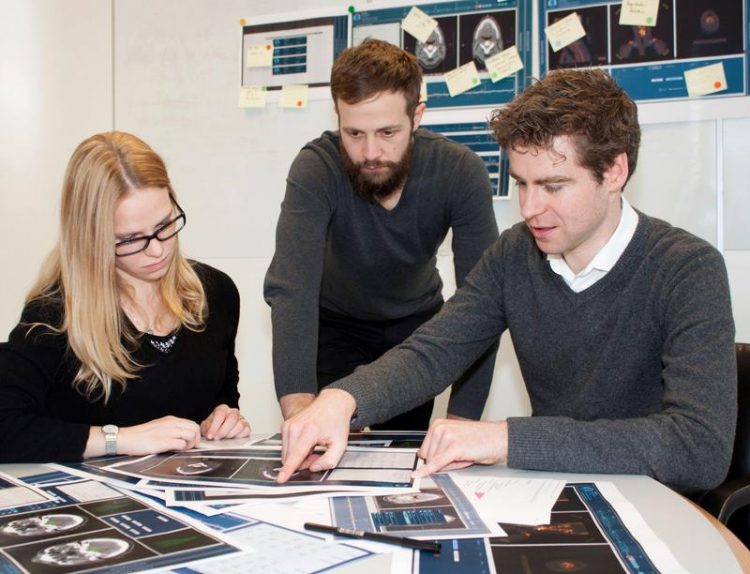The radiation therapy of the future adjusts itself to the patient

In the clinical workshops, scientists from Fraunhofer MEVIS are working together with physicians on the workflow and user experience of the joint radiation therapy software. Fraunhofer MEVIS
Radiation therapy for cancer therapy usually lasts for several weeks. During this time, the situation of the patient changes often: bodyweight decreases, causing the tumor to shrink or change shape. As a result, the distribution of the radiation dose set at the beginning of the therapy is no longer optimal. In the worst case, the radiation can no longer fully hit the tumor, causing part of the radiation to reach and damage healthy tissue.
To avoid such a scenario, doctors have to adjust the direction and dose of the radiation according to current conditions. Until now, this replanning has been a costly and time-consuming procedure. The software developed in the BMBF-funded (Federal Ministry of Education and Research) SPARTA project aims at accelerating this process, thus offering cheaper therapy progress.
Fraunhofer Institute for Medical Image Computing MEVIS has contributed fast and accurate method of transferring the original planning situation to the current patient condition. To make the program as practical as possible, the experts from SPARTA work closely with doctors from renowned cancer clinics.
At the beginning of every radiation therapy, doctors develop a detailed treatment plan based on CT imagery. This plan indicates the body areas that must be irradiated, as well as how often and with what dosage they must be treated. The goal is to completely destroy the tumor while sparing nearby tissue as much as possible. However, this cannot be achieved with a single radiation session. Patients might undergo daily therapy for a month to successfully fight the cancer.
“To ensure that the tumor is targeted as planned, doctors take routine control images of the patient,” explains MEVIS researcher Stefan Wirtz. “That way, they can also recognize whether the patient is lying accurately in the device.” Likewise, these control images help determine whether the tumor has shifted in the body due to a patient´s weight loss over the course of therapy. In such cases, healthy body areas can be accidentally damaged by moving into the radiation path. “When treating tumors in the oral and pharyngeal cavity, the salivary gland sometimes shifts into the radiation area and can become damaged,” says Wirtz’ colleague Stefan Kraß.
To avoid this and to adjust the radiation optimally, doctors must compare the original planning images with the most recent control images. “Often, the doctor must view old and new images and compare them mentally,” Stefan Wirtz explains. “However, our software can align both of them in a single image and transfer the contours of the radiation area.” As a result, doctors can quickly recognize whether the original contours still apply to the current situation. If not, the contours can easily be adjusted with the software tools. “Until now, replanning radiation therapy could take several hours,” says Stefan Kraß. “Our software can accelerate the process considerably.”
To make the software user-friendly, MEVIS experts exchange ideas with radiation therapists several times a year and discuss progress during joint workshops. Is the program easy to operate? Do the algorithms deliver the proper results? Are the software tools as practical as the clinicians desire? “The doctors participate regularly,” emphasizes Wirtz. “This assures that our software will satisfy the demands of the clinical routine.”
One of SPARTA´s clinical project partners, the Ludwig Maximilian University (LMU) in Munich, has already implemented the program for research purposes to evaluate its benefits. “In the current version, the quick contour transfer generates very good re-contouring suggestions. The software will surely find its application in adaptive head and neck radiation therapy,” says LMU doctor Reinoud Nijhuis.
“When the project ends in March 2016, we want to present software that is by and large ready for practical use,” says Stefan Kraß, “and the software maturity achieved through close clinical collaboration might motivate the industry to want to market these results and address the necessary certification.”
The SPARTA project (Software Platform for Adaptive Multimodal Radio and Particle Therapy with Autarkic Extendibility) is funded by the German Federal Ministry of Education and Research (BMBF). It started on April 1, 2013 and will run for three years. The consortium encompasses ten partners, including research institutes, medical technology companies, and university clinics.
http://www.mevis.fraunhofer.de/en/news/press-release/article/the-radiation-thera…
http://www.projekt-sparta.de
Media Contact
All latest news from the category: Health and Medicine
This subject area encompasses research and studies in the field of human medicine.
Among the wide-ranging list of topics covered here are anesthesiology, anatomy, surgery, human genetics, hygiene and environmental medicine, internal medicine, neurology, pharmacology, physiology, urology and dental medicine.
Newest articles

Combatting disruptive ‘noise’ in quantum communication
In a significant milestone for quantum communication technology, an experiment has demonstrated how networks can be leveraged to combat disruptive ‘noise’ in quantum communications. The international effort led by researchers…

Stretchable quantum dot display
Intrinsically stretchable quantum dot-based light-emitting diodes achieved record-breaking performance. A team of South Korean scientists led by Professor KIM Dae-Hyeong of the Center for Nanoparticle Research within the Institute for…

Internet can achieve quantum speed with light saved as sound
Researchers at the University of Copenhagen’s Niels Bohr Institute have developed a new way to create quantum memory: A small drum can store data sent with light in its sonic…





















